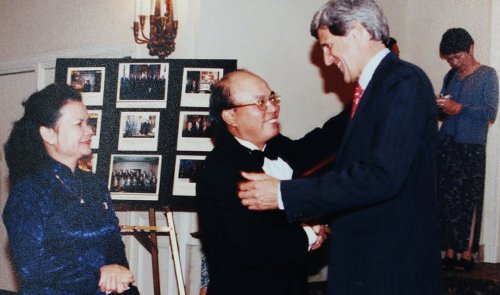Untold stories ‘behind the scenes’ of the path to the normalization of relations between Vietnam and the United States are clearly part of the legacy of the two nations.
The stories started sometime right after 1975, when the war that lasted for around 20 years between the two nations ended.
However, it was the start of a new battle – the process to normalize bilateral relations.
Relations between the two countries were officially normalized in 1995, or 20 years after the end of the war, but some argued that normalization should have come much earlier, sometime after 1975.
However, Nguyen Manh Cam – former Foreign Minister and Deputy Prime Minister of Vietnam – admitted that it was not simple then because of ‘an abundance of disagreements.’
‘An abundance of disagreements’ means so many untold stories and efforts before the national flag of Vietnam flew above the Vietnamese embassy in Washington, D.C., on August 5 in 1995.
The first move from Vietnam
Cam recalled, “Right after 1975, Vietnam sent a message to the U.S. via the Union of Soviet Socialist Republics (USSR) that Hanoi was willing to normalize relations with Washington on the basis of bilateral respect, but the administration of President Gerald Ford didn’t reply because the message was sent through an unofficial channel.”
The U.S. had vetoed Vietnam’s admission into the United Nations by the time.
But the following year, President Ford proposed that Congress pause the embargo policy against Vietnam for six months to seek dialogue with the country, and Secretary of State Henry Kissinger sent a letter to the Vietnamese Minister of State suggesting a meeting to exchange ideas related to normalization.
At the meeting, the U.S. side asked about the transfer of soldiers still under missing in action (MIA) status and the remains of American soldiers killed in the war, while Vietnam demanded the payment of US$3.25 billion in reparations, as mentioned in a document approved in 1973 between Vietnamese diplomat Le Duc Tho and Kissinger.
It should be noted that the U.S. declined to call the amount war reparations, choosing the term economic sponsorship instead.
The difference in requirements for normalization between the two nations lasted during the term of President Ford until 1977.
Vietnam was then suffering great economic problems because of the embargo imposed by the U.S., mistakes in economic management which caused a decrease in rice production and the decline of aid from socialist nations.
Former Vietnamese Trade Minister Le Van Triet said, “One night when I was just going to bed at 1:00 am, the phone rang and a state leader demanded that I immediately fire Vietnam’s commercial counselor in the USSR for failing to complete his duty.
“His duty was to seek sponsorship of iron, steel, fertilizers, pesticides and food from the USSR.”
Triet added he said ‘yes’ to the leader but did not fire the commercial counselor because he knew that no counselor could make a difference then.
The USSR, now Russia, was the only way for Vietnam to seek aid during the embargo years.
Vo Anh Tuan, former ambassador of Vietnam to the UN, recalled that Vietnamese diplomats at the New York-headquartered UN faced numerous troubles thanks to FBI agents.
Vietnamese diplomats were allowed to travel within 25 miles of the UN headquarters, while going beyond the limit needed the approval of U.S. authorities.
All movements of Vietnamese diplomats were under scrutiny from the FBI, and any car carrying Vietnamese diplomats was followed by its agents.
In 1977, when the Democrat Jimmy Carter won the president election, he initiated some changes.
He sent to Vietnam via the USSR a message regarding the normalization of relations and dispatched a delegation led by Senator Leonard Woodcock to the Southeast Asian country for the first time since the end of the war.
A U.S. Air Force C141 aircraft carrying the delegation landed at Gia Lam Airport in Hanoi in March 1977 and was received by Vietnam’s Deputy Foreign Minister Phan Hien.
Differences in the viewpoints of both sides remained almost unchanged after the meeting, but it was a positive move for future negotiations.
Before leaving Vietnam, the delegation received the remains of 12 U.S. soldiers. In addition, U.S. Colonel Paul Mather – a member of the delegation – asked for personal help from the Vietnamese side to find his fiancée, a Vietnamese woman, who failed to leave Saigon (Ho Chi Minh City now) after 1975.
The Vietnamese woman was later allowed to leave for the U.S. to be reunited with her lover, according to Ambassador Le Van Bang, the first Vietnamese ambassador to the U.S.
(To be continued)
























































